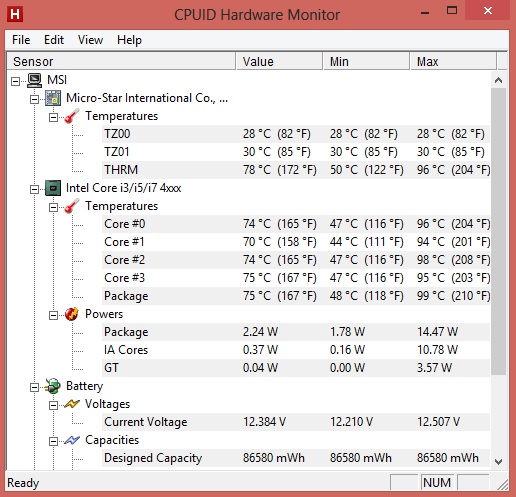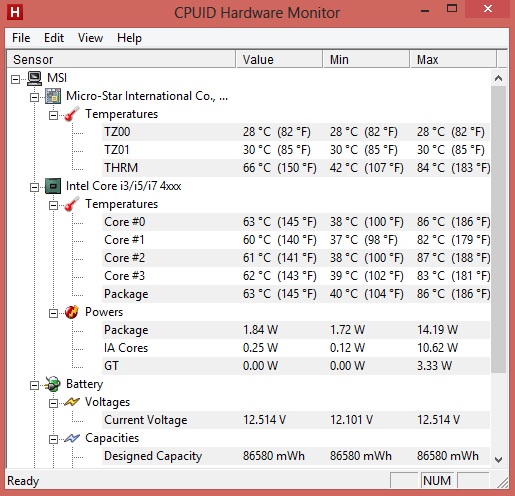MSI GT70 Dragon Edition Notebook Review: Haswell and the GTX 780M
by Dustin Sklavos on June 18, 2013 12:01 AM ESTBuild Quality, Heat, and Noise
So the MSI GT70 Dragon Edition was supposed to be our flagship Haswell and NVIDIA GeForce GTX 780M review. On purely CPU-centric tasks, it didn't disappoint, but whenever the GTX 780M was invoked it started having serious problems. So what happened? Monitoring GPU clocks during testing didn't reveal any issues; in fact, most of the time the 780M was running in the neighborhood of 920MHz. Realistically, it should be pulverizing the outgoing 680M at those speeds.
For comparison's sake, this is what the internal design of the Alienware M17x R4 looks like:
.jpg)
Now here's the internal design of the MSI GT70 Dragon Edition, and hopefully that should give you all the information you need.
.jpg)
At this point, the problem is pretty evident: MSI is trying to cool both a high performance mobile CPU and a high performance mobile GPU with a single fan. The cooling system has one fan with a pair of heatsinks around it: cool air comes in through the back of the GT70 and through the GPU's heatsink array, and then the hot air pulled off of that is used to cool the CPU's heatsink array behind the GT70's exhaust.
The result is that a few runs of games and some stress testing pops up with a HWMonitor screen that looks like this:

The CPU is throttling. Noise levels remain reasonable during gaming, but that's because the CPU is essentially cooking itself. And keep in mind that the GPU is getting cooled first, so the GTX 780M's boost has a healthy amount of headroom to play with. Now, MSI does have a "feature" that can be employed to mitigate thermal issues.

All you have to do to get these thermals is push a touch-sensitive button above the keyboard that toggles the system fan to maximum. Of course, in the process the noise levels wind up being obnoxious and well over 50dB, and performance improves minimally. The fact remains: the MSI GT70 Dragon Edition's thermal design simply isn't enough. I've heard stories of this chassis having thermal issues in earlier models, but at least now I can decisively pin it down.
For a flagship gaming notebook, this is basically inexcusable, and you're really paying for the trio of SSDs in RAID 0 more than anything else. For the same money you can get an Alienware 17 with a GTX 780M. While we haven't tested it yet, it's due in for review soon, and I can tell you that the cooling system is still designed with separate dedicated fans and heatsinks for the CPU and GPU.


_thumb.jpg)
_thumb.jpg)
_thumb.jpg)
_thumb.jpg)
_thumb.jpg)
_thumb.jpg)








115 Comments
View All Comments
MrSpadge - Tuesday, June 18, 2013 - link
When the GPU is pumping 100+ W into those tiny heatsinks, the CPU has to be cooled by some seriously hot air. It's actually almost a heatpipe-miracle that this tiny fan manages to keep things running at all.JBVertexx - Tuesday, June 18, 2013 - link
That thing looks like a laptop right out of the 1990's - probably the ugliest, gaudiest looking laptop I've seen in a long time.You have to wonder, though, if thermal performance is going to be a common issue with these Haswell systems. If it's true that system builders were provided CPUs that produced much less heat than the actual production versions, then what do they do? You've designed your system, lined up your supply chain, and then the CPU's are now producing more heat than your design spec allowed for. I can see the "Max Fan" button being a last minute addition as a way around this issue.
Even so, my Dell Latitude has a better designed cooling system than this Laptop. MSI looks like they tried to cut corners based on the Haswell promise and got bit.
It really is typical MSI though, all gaudy "style" and no substance.
TheinsanegamerN - Thursday, July 11, 2013 - link
i think it was a msi problem. clevo laptops with haswell, the asus laptop with haswell, and the sager models with haswell dont have this issue. only msi does.huaxshin - Tuesday, June 18, 2013 - link
This review is a bust. I just knew it, from the time it took to make this review.The game benchmarks you did is nothing short but plain BS.
1080p benchmarks.
TES Skyrim:
Anandtech: GTX 780M 18% slower than GTX 680M.
Notebookcheck: GTX 780M 26% faster than GTX 680M.
Notebookit: GTX 780M 21% faster than GTX 680M.
StarCraft 2:
Anandtech: GTX 780M is 12% slower than GTX 680M.
Sadly nobody else have tested it. Nvidia got +20% with the 780M over the GTX 680M. Pretty much logical. 12% slower? Give me a break
Tomb Raider:
Anandtech: GTX 780M is 3% slower than GTX 680M
Notebookcheck: GTX 780M is 102% faster than GTX 680M.
I won`t even bother going through the benchmarks where the GTX 780M leads, but its most likely very inaccurate as pretty much every game benchmark in your test.
Source: Notebookcheck and Notebookreview
I previously used Anandtech as a source for information about mobile products, but seeing that you can`t even review a product properly, this site goes far down my must-read list.
I`m actually sick in my stomach that you guys messed up this much with a new flagship GPU.
You ought to be ashamed of yourself for not double checking your data before pushing out a BS review like this one. You numbers doesn`t make any sense at all.
kogunniyi - Tuesday, June 18, 2013 - link
Did you even read the review? That was the point...kogunniyi - Tuesday, June 18, 2013 - link
I'll spell it out: the GTX 780m is underperforming in the MSI.huaxshin - Tuesday, June 18, 2013 - link
No its not. Go read the GT70 review on Notebookcheck.They had no CPU throttling OR any performance issues with the GTX 780M
This review should be deleted and redone.
kogunniyi - Tuesday, June 18, 2013 - link
OK, I came on a bit too strong. The results in the review are bizarre, but they do provide reason to pause: we have no guarantee that the MSI's cooling system can handle a heavy CPU/GPU OC over a long time. The bridge doesn't help much during a load that stresses the CPU and GPU. Notebookcheck reported throttling and up to 90C for the CPU and GPU.Of course, my thoughts might be misplaced, and the issue might be the 180W power supply.
huaxshin - Tuesday, June 18, 2013 - link
That is plain wrong.The thermal capacity inside the GT70 is more than capable of cooling the 4700MQ and the GTX 780M. Visit Notebookreview forum and read reviews from owners of GT70, or read any other reviews on the internet. Nobody have these high temperatures when gaming.
The temperatures in the Notebookcheck review is when they are running Prime95 and Furmark. Not remotely close to any scenario a user will EVER encounter.
The temperatures when using it is much lower.
BobBobson - Tuesday, June 18, 2013 - link
Blah Blah Blah........Why don't you go cash in your MSI company pay cheques you paid shill.
This review is equivocal with my and many other peoples experiences with the new GT70 Haswell notebooks. Why would Anandtech dishonestly smear a product of a major computer tech manufacturer? For the same reason you and your type scour the internet talking a sweet game about every bit of excrement that comes out MSI's back-end?
If there was a bit more honesty on the internet when it comes to tech products, people would have a lot less hassles in their lives and the world would be a better place. I commend Anandtech on this honest GT70 review, the first honest review I have seen,